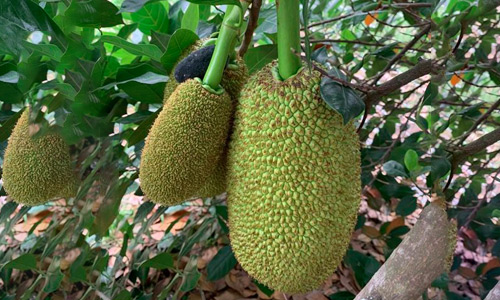|
Division
|
Angiosperms
|
|
Class
|
Dicotledons |
|
Subclass
|
Apetalae |
|
Order
|
Urticales |
|
Family
|
Moraceae |
|
Genus
|
Artocarpus |
|
Species
|
heterophyllus |

|
Etymology: |
Artocarpus: artos means bread in Greek, and carpus: fruit in the same language. |
|
Botanical name
|
Artocarpus heterophyllus Lam. |
|
Local/Trade names:
|
Jack-Fruit Tree, Katahal. |
|
Conservation status: |
Commonly cultivated throughout India for it edible fruits. |
|
Digonestic features: |
Bark dark grey; fruits large pendant from the trunk and large branches of the tree. |
|
Description: |
Large tree. Bark dark grey. Leaves dark green, 10-16 cm long, elliptical or obovate, shining above. Male and Female inflorescence on the same tree; male forming small finger like receptacles; female (fruit) 30-45 cm long, 15-30 cm in diameter pendant from a short, stout stalk from the trunk and larger branches. Seeds 3-4 cm, kidney-shaped. |
|
Phenology: |
Fls.: Mar.-Sept. Frts.: July-Sept. |
|
Distribution: |
Western Ghats. Myanmar, Sri Lanka, Malaya and Brazil. |
|
Where to see it: |
Nursery and Medicinal Plant Garden. |
|
Uses: |
Fruits are 30-60 cm long, containing a large number of seeds, each enclosed in a yellowish juicy sheath. Two varieties: Kapa with sweet and fleshy pericarp; and Barka, inferior, with mucilaginous sour pericarp. Unripe fruits used as a vegetable or pickled; ripe ones eaten fresh or preserved in syrup. Seeds are rich in starch and eaten after roasting or boiling. Wood used for general carpentry work, plain furniture, brush backs, turnery, and inlay work. Also employed for musical instruments. Wood yields a yellow colouring matter. |
Chief Conservator of Forests & Chief Wildlife Warden is the Head of the Department. There is one post of Conservator of Forests & two posts of Deputy Conservator of Forests viz.